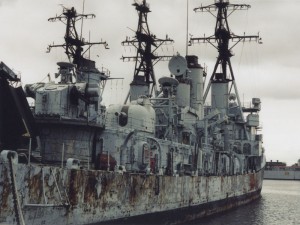 In the crowded world of floating naval memorials, hope springs eternal. In Jacksonville, an effort by the Jacksonville Historic Naval Ship Association to save an elegant former destroyer, the Charles F. Adams (DDG 2), moved ahead, getting support from the Jacksonville City Council. (The picture with the post is the ship as of 2002…a pity, huh?)
In the crowded world of floating naval memorials, hope springs eternal. In Jacksonville, an effort by the Jacksonville Historic Naval Ship Association to save an elegant former destroyer, the Charles F. Adams (DDG 2), moved ahead, getting support from the Jacksonville City Council. (The picture with the post is the ship as of 2002…a pity, huh?)
Now, according to the article, they just need money. Eight million dollars. Not much, but it is another mouth to feed in an already crowded nest of resource-starved floating naval memorials (including the Olympia):
But in setting up such a museum, supporters will have to overcome the sort of problems that have recently plagued other floating memorials.
Earlier this year, the Independence Seaport Museum in Philadelphia said it couldn’t afford to keep afloat the USS Olympia. That museum is suffering through a financial crisis similar to the one facing South Carolina’s Patriot Point, where several vessels await maintenance work for which funds don’t exist.
“These are naval vessels you’re trying to preserve,” said Craig Hooper, a San Francisco-based naval analyst with an interest in maritime museums. “They’ve been hard used over their lifetimes. It’s a complex piece of machine that requires trained maintenance.”…
So far, O’Neil said, the two organizations involved in the fight have raised about $100,000 in cash and pledges, including a donor who’s providing the 150-foot mooring lines that will tie up the ship.
Still needed are about $3 million to refurbish the ship, $300,000 to tow it to Jacksonville and $5 million to build the state-of-the-art pier that O’Neil said will hold the ship through storms worse than the city has ever seen.
If the group is able to raise such funds, and if its business plan proves viable in terms of bringing in enough money to keep the ship afloat, the USS Adams museum could be a success.
“If you have a good business plan, you’re going to do well. If you have a sound preservation plan, you’re going to do well,” said Hooper, the naval analyst. “But you can’t go into it lightly.”
I think these guys in Jacksonville are going into this with their eyes wide open. Go visit ’em.
That said, I am beginning to think that it is time for this nation to revisit the long-term preservation of floating naval memorials. Even with minimal maintenance, retired steel ships can survive for about a half century–And then a whole array of corrosion-related problems emerge. First, the trained guys–the old crew, the old builders–die off, and the accumulated knowledge of shipboard systems, maintenance issues and preservation matters fade away.
Then there’s time–every time a ship hits the dry-dock for a nice round of sandblasting and repainting, steel comes off. Or there is steel-eating corrosion. At some point, patches can’t do the job, and then, well, what? Where do we get the money to, in essence, rebuild a vessel that, essentially is floating on a metal equivalent of an eggshell? Or to maintain the watertight integrity of an old steel warship?
Nobody ever really thinks that far ahead.
Instead of taking an aggressive approach to preservation–planning for permanent coffer-dams or the like–organizations seem eager to try to keep the vessels afloat. That may work–if you have top-notch funding and maintenance. But for the vast majority of the naval memorials afloat today, there comes a time when keeping the vessel moored to a pier may not be the best option–and sadly, by the time most museums get to that point, the vessel has already deteriorated to the point where the maintenance problems are dire.
I would be very interested to see how a ship–if it was taken directly from museum hold to dry-dock and then to a filled-in coffer-dam berth–how it does over time. Would it last longer? Would more monies be able to be leveraged for other activities? Or is it worth fighting the complex engineering challenge of keeping memorials afloat on a comparative shoestring?
I would really like to see the Navy take this issue–the preservation of America’s naval and maritime heritage–and start a national discussion. And…maybe, in the case of the Olympia, directly supporting efforts to preserve key aspects of America’s naval history.
It matters–and hopefully, given that SECNAV Ray Mabus has–in a move that really separates him from his predecessors–started regularly appearing at the Navy’s floating military memorials, somebody in this Administration gets it. Now…where is that Navy-generated catalog of key floating naval memorials and a pot of money to support ’em?
